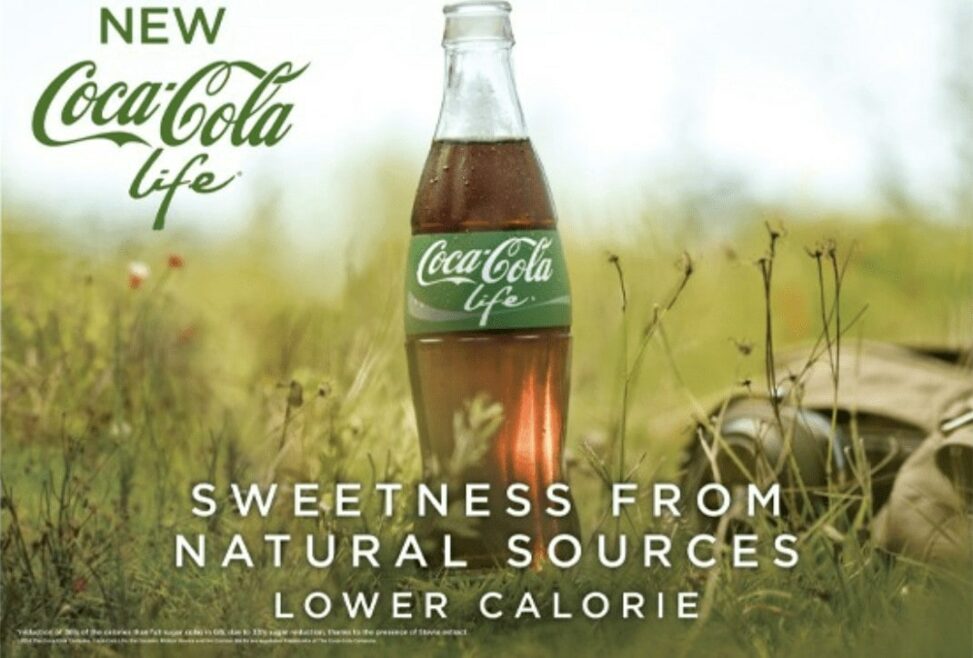With Coca-Cola being one of the most famous and well-known brands in the world, it could be considered as a shock to most that the billion-dollar corporation would commit greenwashing. In 2009, the brand launched their newest innovation to soda with “Coca-Cola Life,” which would lower the average sugar intake, as well as calories, while still allowing the public to enjoy a crisp bottle of Coca-Cola. The product was intended to be a much healthier alternative for customers to relish, while further leading the consumers to believe in the advertisement that the bottles were in fact plant bottles, which resulted in the product having no economically friendly value, fooling the consumers to think they were acting green. The advertisement was set in a meticulous scene with neutral green and brown shades to make the bottle appear as though it was growing from the ground. To further add to this illusion, there are a few weeds that are clearly standing and growing around the bottle, making it appear as though the bottle is, in fact, growing from the ground. With this idea and image in mind, it attracts the buyer into believing they are choosing the wiser and healthier product. The background of the image is blurred to intensely highlight the Coca-Cola Life bottle, and the bottle itself uses green labeling to make the consumer think their choice in beverage is not only refreshing, but also helping the economy. The bottle takes up most of the image and highly emphasizes its importance of the product and less on the contributing elements within the ad, which focuses the consumers first glance onto the product. The lack of shadowing on the product, or any shadowing for that matter, gives the product a soft, fresh, and relaxing wave of emotion over the consumer when they first glance at the advertisement. They can feel at peace with the fact they are choosing Coca-Coca Life over any other product. The liquid itself appears to be lighter than the average Coca-Cola drink, and additional highlights at the bottom right side of the bottle give off the appearance of a lighter and fresher product, making it even more desirable. The advertisement highly plays into its’ environment, although there are no economically friendly benefits to the product whatsoever. With the product and labeling consisting of earth-like tones, it made the advertisement simple to embellish the natural and green-like aspects of nature to further produce the idea of its environmentally friendly components, but, as it has been uncovered, the idea of Coca-Cola Life being green was all a scam. However, I believe the ad is in fact convincing for its audiences. Considering Coca-Cola is such a well-known brand that targets essentially all audiences, they would be able to fund their promotion of their green movement instead of promoting real green products. With that in mind, the advertisement shows all the components needed to convince the consumers into thinking their product is green with no physical proof of green practices happening within their corporation. The green labeling on the bottles and green cans being sold everywhere, the consumers would be convinced that the product is economically friendly. The ads take this concept even further with their specific promotions being set in natural spaces. With brands implementing green products after natural disasters or economic downfalls, it would only make sense for Coca-Cola to promote their new product as 2009 faced many natural disasters consisting of typhoons, earthquakes and global warming on the rise all around the world. The green implementation would give consumers a sense of hope, and with Coca-Cola reaching billions of people, the brand as a whole would shed a new light. Especially in a time when the population becomes increasingly worried of the state of our economy and the dangers global warming can cause on the world, consumers would feel the need to take any precaution possible to live a more sustainable and greener life. The new product would ease the buyers into consuming their product to feel better about their choices in green products, which is why the product would have been successful in its time. Now, realizing that Coca-Cola did in fact greenwash, Coca-Cola Life isn’t seen as much in stores, or at all for that matter. With so many popular corporations deceiving the public with their greenwashing antics, it can be difficult to believe who is selling products to keep a greener society. Coca-Cola may have been successful in its time with their promotion of plant bottles and healthy beverages; focusing their advertisements to fool consumers into the natural settings, neutral colours and focusing the gaze onto its refreshing and economically friendly branding, but with the truth of its corporations actual practices, there would be no questioning as to why Coca-Cola Life has lost its popularity.
Bibliography
Aggarwal, Priyanka, and Aarti Kadyan. “Green Washing: The Darker Side of CSR.” Forum4researchers.com. Last modified May 2014. https://www.forum4researchers.com/cw_admin/docs/IJIRP-MAY-14-03.pdf.
“The Effect of Greenwashing on Switching Intention with Green Perceived Risk as a Moderation Variable.” JP Fakultas Ekonomi Dan Bisnis Unsoed. Last modified 2023. https://www.jp.feb.unsoed.ac.id/index.php/sca-1/article/viewFile/3815/2523.
“It’s all About the Green: the Economically Driven Greenwashing Practices of Coca-Cola.” PlumX Metrics. Last modified 2020. https://plu.mx/plum/a/?repo_url=https://idun.augsburg.edu/honors_review/vol6/iss1/13&theme=plum-bigben-theme.


Provide Feedback